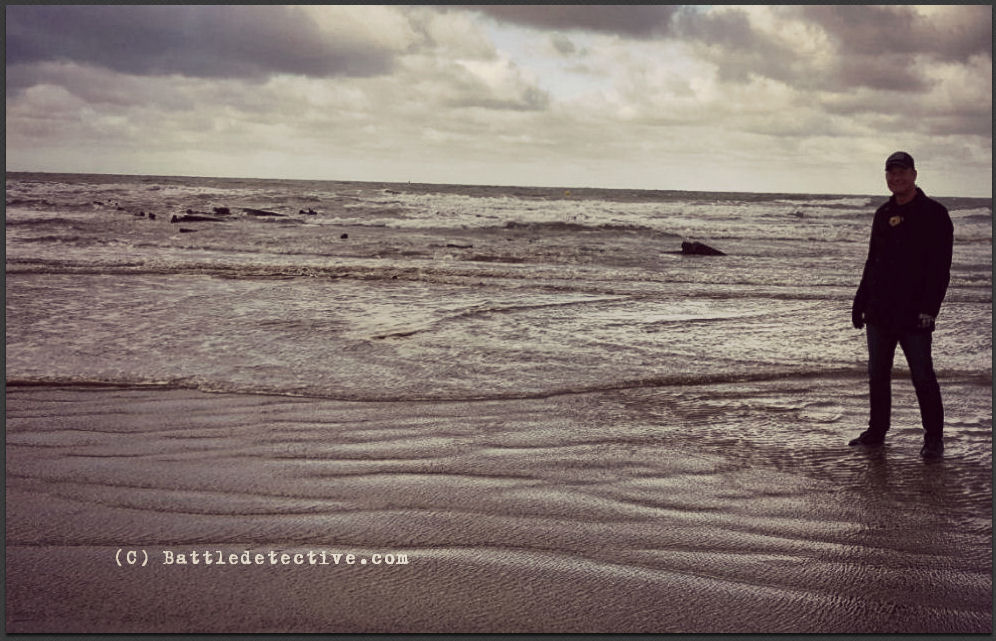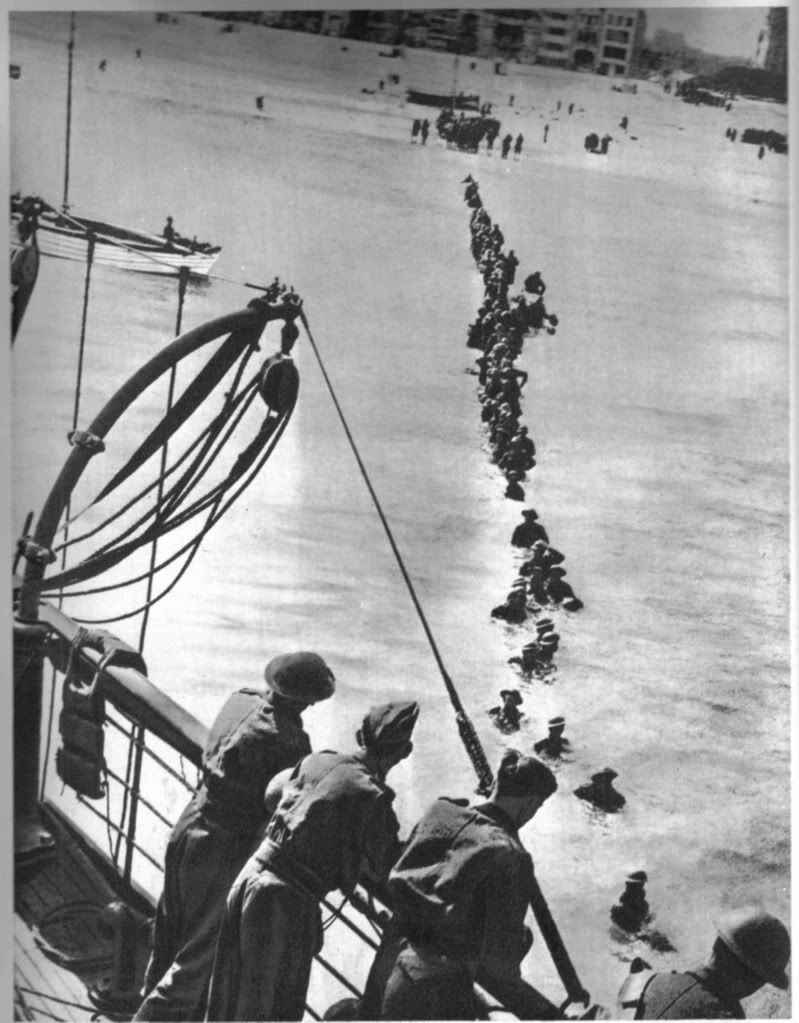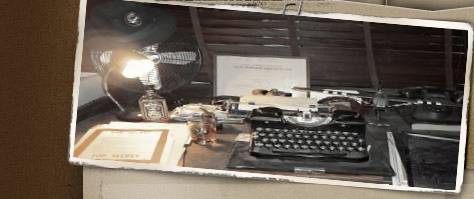
Battle Relics: Three (3)
beached sea vessels of the
Evacuation of Dunkirk in May and
June 1940.
Finding place: City of
Dunkerque, Region of
Nord-pas-de-Calais, Departemant
Nord, Republic of France and the
communities of Leffrinckoucke,
Zuydcoote and Bray-Dunes.
Period Covered:
27MAY1940 to 4JUN1940
Date: 30&31DEC 2015
GPS locations: GPS Locations
of the remains of the vessels:
1) “Claude London” (51°04'115"N
2°28'024"E)
2) “HMS Crested Eagle” (51°04'560"N
2°29'461"E)
3) “HMS Devonia” (51°04'773"N
2°30'169"E)
|
(click to enlarge)

Battle Detective
near the wreckage of
HMS "Crested Eagle" on Zuydcoote
beach
at low tide on 26 November 2017 |
Introduction:
It is known to this agency that the
location of the “Miracle of Dunkirk
of 1940 in World War II” in Northern
France is not commonly known to the
general public. Our agents therefore
travelled to the beaches of Dunkirk,
Zuydcoote and Bray-Dunes in the
French Department Nord, to document
the remains of vessels stranded on
the beaches near Dunkirk during
their crews’ attempts to evacuate as
much Allied troops from the Dunkirk
Salient to English ports as
possible.
SYNOPSIS: The Dunkirk evacuation,
codenamed Operation “Dynamo”, also
known as “The Miracle of Dunkirk”,
was the evacuation of Allied
soldiers from the beaches and harbor
of Dunkirk, France, between
27MAY1940 and 4JUN1940, during World
War II. The operation was ordered by
the British Expeditionary Force (BEF)
High Command, when large numbers of
Belgian, British, and French troops
were cut off and surrounded by Nazi
forces, during the Battle of France. |
|
(click to enlarge)
1)_small.jpg) 2)
2)_small.jpg)
1) Artillery piece in front
of the Memorial Museum of the Battle
of Dunkirk (closed during winter
season)
2) Monument for the Battle of
Dunkirk located between the
evacuation pier and the beach at
Dunkirk |
After Nazi Germany invaded Poland in
SEP1939, marking the beginning of
the Second World War, the BEF was
sent to aid in the defense of
France. Nazi Germany invaded Belgium
and the Netherlands on 10MAY1940,
and three of their Panzer corps
attacked France through the Ardennes
and sped to the English Channel.
By 21MAY1940, the Nazis had trapped
the BEF, the remnants of the Belgian
forces, and three French armies in
an area along the Northern coast of
France. General John Vereker,
Commander of the BEF, immediately
saw that evacuation across the
Channel was the best option and
began planning a withdrawal to
Dunkirk, the closest location with
suitable port facilities. On
22MAY1940, a halt order was issued
by the German High Command, with the
approval of Adolf Hitler. This gave
the trapped Allied forces time to
deploy defensive works and retreat
large numbers of troops toward
Dunkirk, to fight the Battle of
Dunkirk. From 28–31MAY1940, in the
Siege of Lille, the remaining 40,000
troops of the French 1st Army fought
a delaying action against seven Nazi
divisions, including three armored
divisions.
On the 1st day of the evacuation,
only 7,669 men were evacuated, but
by the end of the eighth day, a
total of 338,226 soldiers had been
rescued by a ragtag fleet of over
800 boats. Many of the troops were
able to embark from the harbor’s
protective pier onto 39 British
destroyers and other large ships,
while others had to wade out from
the beaches, waiting for hours in
the shoulder-deep water: |
|
(click to enlarge)
 |
|
Some
of the evacuated soldiers were ferried from the beaches to the
larger ships by the famous “Little
ships of Dunkirk”, a flotilla of
hundreds of merchant marine boats,
fishing boats, pleasure craft, and
lifeboats called into service for
the emergency. The BEF lost 68,000
soldiers during the French campaign
and had to abandon nearly all of
their tanks, vehicles, and other
equipment. |
CONCLUSION:
The success of the biggest
evacuation in military history, a
“Disaster turned to Triumph”, gave a
great boost to British morale, and
is now seen as a major turning point
of World War II.
|
|
EXHIBITS:
Tangible evidence of Operation
“Dynamo” are the wreckages of
stranded vessels deployed 75 years
ago to evacuate Allied troops off
the beach.
The Dunkirk pier (locally known as 'môle') has been demolished after
World War Two and rebuilt to modern
standards. We visited the beaches of
Dunkirk and the coastal town of Zuydcoote on 31DEC2015. This day saw
a relatively low tide water level of
42.52 inches (1.08 meters) at
11:18AM, compared to other days
before and after this date.
On the beaches of Leffrinckoucke,
Zuydcoote and Bray-Dunes, East of
the city of Dunkirk proper, we found
the remains of the vessels “Claude”,
“Crested Eagle” and “Devonia”
mentioning their locations from east
to west as shown in this
diagram. |
|
(click for
enlargements) |
|

Now&Then comparison of the beach
at Dunkirk shortly after the
evacuation

Wreckage of HMS "Crested Eagle" on
the beach at Zuydcoote
.jpg)
Nazis posing with the beached
wreckage of HMS "Crested Eagle" |
“Claude; the water supply lighter
at Leffrinckoucke
Claude was launched on 13MAY1915 as
an X-lighter named X.37.
She had a Diesel engine and measured
105.5 ft in length with a 21ft beam.
Her first owner was the Admiralty in
London who, in 1922, sold X.37 to
T.R. Sargent of London who then used
her as a water tanker and renamed
her “Claude”.
In 1940 “Claude” was requisitioned
by the Admiralty for Operation
“Dynamo”, towed to Dunkerque by tug
“Fairplay One” with water for the
troops and abandoned on the beach at
Leffrinckoucke on 29MAY1940, where
her remains are still visible. |
|
.jpg)
Close-up from a photo taken from the
sea, looking inland towards the
beached "Claude" |
|
(click for
enlargements)
_small.jpg) _small.jpg) _small.jpg) _small.jpg) _small.jpg) _small.jpg) _small.jpg)
"Claude" as we
found her on the beach of
Leffrinckoucke on New Year's Eve
2015 |
“HMS Crested Eagle”; the bombed
evacuation ship at Zuydcoote
First owner of the HMS “Crested
Eagle” was the General Steam
Navigation Co..
She was launched in 1925 built by J.
Samuel Whithe & Co, measured
299.7x34.6x11.1 ft. and was equipped
with triple expansion diagonal
engines.
The well-known Thames paddle-steamer
“Crested Eagle” was taken over by
the Admiralty during WWII to be used
as a minesweeper. On 29May1940, when
assisting in the evacuation of the
British Army from the Dunkirk
beaches, she was bombed by German
aircraft.
At the time of the attack, “Crested
Eagle” was carrying about 600 troops
in addition to her crew. She was set
on fire and was run ashore on the
Zuydcoote beach, over 300 of those
on board being either killed or
drowned. |
|
(click for
enlargements)
_small.jpg) _small.jpg)
HMS "Crested
Eagle" in her glory days as a steam
paddler |
|
(click for
enlargements)
_small.jpg) _small.jpg) _small.jpg) _small.jpg) _small.jpg) _small.jpg)
""Crested Eagle"
as we found her on the beach of
Zuydcoote on New Year's Eve 2015
Note the stainless steel memorial
plaque installed six months earlier |
|
“HMS Devonia”;
the damaged ship beached at
Bray-Dunes
This pre-war Bristol Channel paddle
steamer had been commissioned by the
Navy in 1939 and converted into a
minesweeper. Joining the 7th
Minesweeping Flotilla at Granton in
Scotland, she carried out several
operations before assisting the
evacuation on 30May1940. She had
been helping to transport troops off
the beaches at De Panne on the
Belgian coast, but came under heavy
air attack. Although she didn’t take
a direct hit, she suffered a number
of near misses which caused a fair
amount of damage; enough to make it
unlikely that she would be able to
make it back across the Channel.
Instead, her skipper was ordered to
beach her at Bray-Dunes. |
|
(click for
enlargements)
_small.jpg) _small.jpg) _small.jpg)
HMS ""Devonia" in her
glory days as a steam paddler
(click for
enlargements)
.jpg)
_small.jpg) _small.jpg) _small.jpg) _small.jpg) _small.jpg) _small.jpg)
HMS "Devonia" characterized by her
two funnels, on the beach at
Bray-Dunes, photographed shortly
after the 1940 Evacuation and later
during the Nazi occupation of
France. Note the various stages of
decay of the wreckage which has been
surfacing from choppy, salty water
twice a day during low tide since
1940. |
|
(click for
enlargements)
.jpg) .jpg)
""Devonia" as we
found her on the beach of
Brays-Dunes on New Year's Eve 2015
|
9APR2016 UPDATE:
We revisited the beaches east of
Dunkirk in Northern France today
which saw an extremely low tide at
minus 9,05 inches; over a yard less
water then the last time we visited
here.
We were able to walk around, on dry
land, the wrecks of "Crested Eagle",
"Devonia" and "Vonette" and caught a
clear glimpse of the mysterious
unidentified vessel on the beach of
Zuydcoote.
|
|
HMS "Crested Eagle": |
|
(click for
enlargements)
_small.jpg) _small.jpg) _small.jpg) _small.jpg)
_small.jpg) _small.jpg) _small.jpg) _small.jpg) _small.jpg) _small.jpg) |
First image shows a scale model of
HMS "Crested Eagle" when she moored
on the pole (pier) at Dunkirk to let
soldiers board, prior to being hit
in mid-sea later. Photo taken in the
excellent
Dunkirk Operation "Dynamo" memorial
Museum.
Last images show a vessel behind
"Crested Eagle" which has not been
identified by the experts of "Epaves
au large de Dunkerque" and is
designated by them as Enconnu1
(Unknown1). |
|
HMS "Devonia": |
|
(click for
enlargements)
_small.jpg) _small.jpg) _small.jpg) _small.jpg) _small.jpg) _small.jpg) _small.jpg) |
Wooden cargo sail ship "Vonnette":
Actually not a combat scene: the
remains of wooden sail ship "Vonette"
which beached here in 1929.
Battle Detective posing as if
standing on her deck in Vonette's
original upright position. |
|
(click to enlarge)
.jpg) |
|
|
|
Back to Battlerelics
 |
|
|













